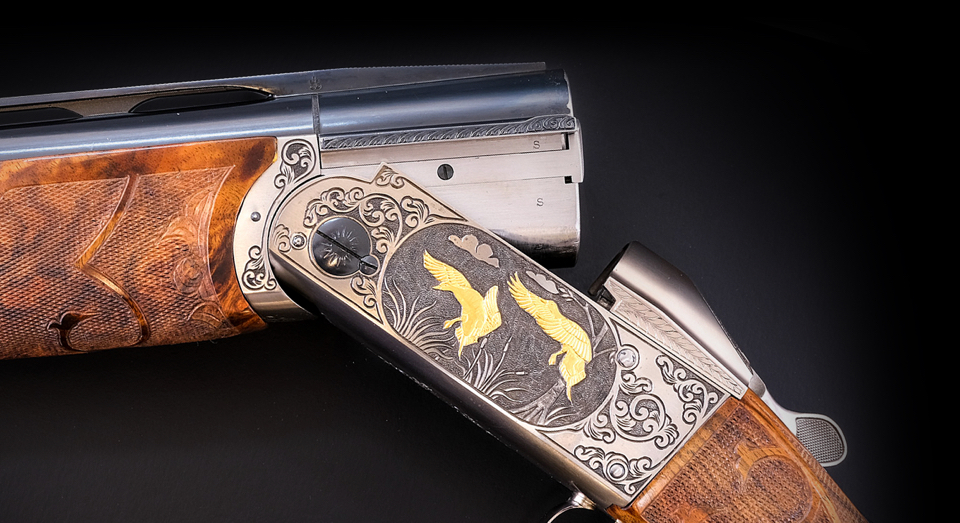During the mid-19th-century, during the days of muzzle-loader, firearms makers across the globe were trying to design a gun with a higher rate-of-fire. Among the many experimental muzzle-loader rifle designs, one of the most interesting iteration is the revolving rifle. Revolving rifles are a testament to the ingenuity of gunsmiths in a time before widely available high-caliber cartridge rounds.
The revolving rifle was unique for its time, in that few experimental rifles of the day saw use on the battlefield. But, the Colt revolving rifle is among the few that saw active military service in the United States Army between 1855 and 1863. And, today, authentic revolving rifles are highly sought-after collectibles.
What’s a Revolving Rifle?
Do you know how long it takes to load a muzzle-loader rifle from the 1850s? For a proficient soldier of the day to load and fire a single round, it takes about 20-seconds. A lot of damage can befall a soldier in those 20-seconds between rounds.
For the army, a higher fire-rate means an upper-hand on the enemy and more assured victory. And, by 1836, Samual Colt proves that a higher fire-rate is possible when he takes out a patent on the Colt Patterson hand-held revolver.
The Colt Paterson revolver was the most popular gun in mid-19th-century American. It was the most reliable and fast-firing revolver, to date. Compared to the 20-seconds it takes to load and fire a muzzle-loader, the Colt Pattersons five-round cylinder takes around 6 seconds to fire empty.
Samual Colt knew that the Patterson revolver was the most viable foundation upon which to design a rifle with a higher rate-of-fire. So, Colt embarked on the quest to craft a rifle that functioned like his Patterson revolver, incorporating a rotating cylinder. And, in 1855, the Colt Armory – just down the road, in Hartford, Connecticut – begins rolling out the first model of its revolutionary revolving rifle.
Revolving Rifles are a Great Idea – with Unforeseen Flaws
To begin with – Colt’s model 1855 revolver carbine is a great design, on paper. It solves a fundamental issue of cap-and-ball muzzle-loaders, which is the time it takes to load rounds. The solution becomes one of the first examples in the history of soldiers utilizing, what we now call, spare magazines.
The model 1855 revolving rifle features a removable 5-round cylinder, which effectively enabled soldiers to carry spare cylinders on their person. When the 5-rounds are spent, a soldier pops out the cylinder and snaps in a fresh one. This is the most effective and lasting concept that Colt’s revolving rifle brings to fruition.
The revolving rifle, however, runs up against the same obstacle as other rifles of the day attempting to achieve a higher rate-of-fire. Rifles need to fire larger caliber ammunition with a greater amount of black powder. But, the black powder used in cap-and-ball firearms tends to pepper the shooter with hot embers and sparks.
Colts revolving rifle cylinder chambers remain exposed to sparks and embers emitted when firing the weapon. This is a problem because each of the other loaded chambers has a tendency to ignite and misfire at once. Often, in these instances, the shooter was wounded more severely than the target.
Today, firearms are chambered for cartridge ammunition, which keeps the gun powder from accidental ignition. But, in the mid-1800s, cartridge-fire ammunition was unstable in higher calibers and prohibitively expensive to manufacture.
The Colt 1855 revolving carbine rifle, also exposed a crucial design flaw in the efficacy of how the shooter must hold the firearm. Soldiers instinctively held the rifle like a muzzle-loader, with the non-dominant hand holding the barrel for support. In the event of a misfire, however – where all 5-rounds go off at once – the shooter’s hand is directly in the line-of.
Where Did revolving rifles Go?
In order to safely fire the weapon, the shooters stabilizing hand has to be oriented exactly like a revolver pistol – with one hand over the other. This presents obvious stability issues when attempting to steady a rifle with a 24-inch barrel. So, with the higher fire-rate on the battlefield, also came a greater risk of accidental injury.
Revolving rifles predate the revolutionary Henry rifle and Winchester 1873. The latter, repeater rifles become a better solution to the fire-rate issue, in no small part, due to the advent of centerfire rifle-cartridge ammunition. In the latter half of the 19th-century, the cost of manufacturing higher-caliber cartridge ammunition becomes cheaper and quickly becomes the new standard for rifles.
Colt adapts to the new ammunition standard by re-chambering its revolving rifle for center-fire cartridges. The advancement in ammunition, however, spurs a new renaissance for rifle design and the henry repeater soon emerges as the most viable high rate-of-fire rifle design.
Are Revolving Rifles Still Available?
Today, several gun manufacturers produce replicas of the Colt M1855 Revolving Rifle that is chambered from .36 to .64 caliber. A replica might run you about $400 to $500. But, if you’re looking for an original, you will have some stiff competition.
The best place to find an authentic 19th-century model is at a gun auction. Since CT Firearms Auction is just a few miles from the firearms capital of America, original revolving rifles come through regularly. And, depending on the condition of the firearm, they can go for a hammer price of up to around $10,000.
Final Thoughts
Only about 5,000 Colt M1855 Revolving Rifles were produced in the 7-years of its production. And, CT Firearms Auction – being only a few miles down the road from Colt’s historic factory – we see a number of these unique classics come through our doors.
Want to learn more about classic firearms and cool collectible guns? If you like this article, read more about cool and collectible guns on our blog. And, share the history of unique firearms with your social media community.
